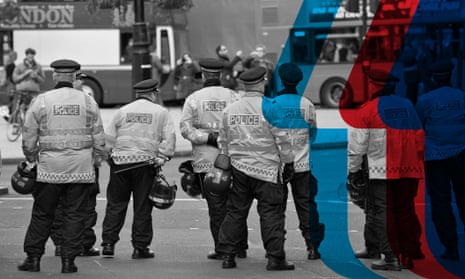The Metropolitan police are disproportionately using some of the potentially deadliest types of force – stun guns and restraint – against black people, analysis shows.
Figures analysed as part of the Guardian’s Bias in Britain project show the Met Tasered black people more than four times as often as white people, and used restraint four times as often. The findings are based on the Met’s use-of-force data from April to September this year and London population estimates.
The Met used a Taser 3,167 times in the period, and ground or limb restraints 10,657 times. Analysis shows that 13 in every 10,000 black Londoners were Tasered, compared with three in every 10,000 white Londoners. Restraint was used on 39 in every 10,000 black people in the population and 10 in every 10,000 white people.
Black people accounted for 29% of all London arrests in 2016-17, the last period for which statistics are available, and 40% of all those Tasered in April-September this year.
The campaign group Inquest has counted 18 deaths since 2004 where a stun gun was involved, and it is widely acknowledged that Tasers can cause serious injuries.
Charities said the data showed a disparity that could be explained in part by an assumption that black people are dangerous.
“[There are] racial stereotypes woven into police culture and practice that can lead to disproportionate and fatal use of force,” said Deborah Coles, the director of Inquest, which campaigns to reduce the number of deaths in police custody.
“A lot of the cases that we’ve worked on have presented a disturbing picture of violence, racism and inhumane attitudes … ascribing to black people characteristics of extraordinary strength, dangerousness and criminality.”
Dame Elish Angiolini, who in 2017 wrote a government-commissioned review of deaths and serious incidents in police custody, said a lack of accountability over such incidents was damaging trust in the police.
“The disproportionately high number of deaths of black men in restraint-related deaths, often in contentious circumstances, is a serious issue,” she said. “Police officers must be held to account through the legal system. Failure to do so undermines community confidence in the police and is damaging to police and community relations.”
Coles said the use of restraint could escalate rapidly. “People in real distress may be struggling because they can’t breathe. Police can lose sight of this, responding with more restraint, which can have deadly outcomes.”
The police definition of use of force ranges from trying to talk someone down, to handcuffing, to drawing (rather than using) weapons. The most common use-of-force tactic is handcuffing.
Coles said the findings were unsurprising. “These aren’t isolated problems, they are part of a systemic problem – in particular racism and discrimination.”
Police forces have been required to provide use-of-force data since April 2017, although the Guardian found that a number of forces have not kept up with the duty.
